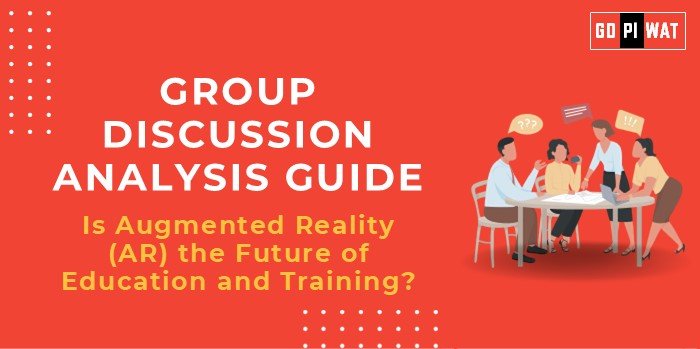📋 GD Analysis Guide: Is Augmented Reality (AR) the Future of Education and Training?
🌐 Introduction to the Topic
Opening Context: Augmented Reality (AR) is reshaping traditional education and training by bridging the gap between theoretical knowledge and practical application, offering immersive, hands-on learning experiences.
Topic Background: From virtual classrooms to AR-powered simulations, this technology has grown exponentially, with a market valuation of $9.5 billion in 2023. AR is particularly impactful in fields requiring practical skills, such as medicine, engineering, and aviation. The ongoing digital transformation in education emphasizes AR’s relevance globally.
📊 Quick Facts and Key Statistics
- Market Growth: The global AR market is projected to reach $29.6 billion by 2024, with a compound annual growth rate (CAGR) of 39.5% from 2024 to 2033.
- Educational Impact: 89% of students reported that AR in education helped them understand the subject matter better.
- Training Efficiency: AR can reduce training time by 40% and improve retention rates by up to 80%.
🤝 Stakeholders and Their Roles
- Educational Institutions: Integrate AR into curricula to enhance learning outcomes.
- Technology Companies: Develop AR tools and platforms for educational purposes.
- Government Agencies: Provide funding and policy support for AR adoption in education.
- Students and Professionals: Benefit from immersive and practical learning experiences.
🏆 Achievements and Challenges
Achievements:
- Enhanced Engagement: AR has been shown to increase student engagement and motivation.
- Improved Learning Outcomes: Students using AR have demonstrated better understanding and retention of information.
- Corporate Training Success: Companies utilizing AR for training report significant improvements in employee performance.
Challenges:
- High Implementation Costs: The expense of AR hardware and software can be prohibitive for some institutions.
- Digital Divide: Limited access to AR technology in underprivileged areas exacerbates educational inequalities.
- Technical Challenges: Issues such as software compatibility and the need for technical support can hinder AR integration.
🌍 Global Comparisons
- United States: Extensive use of AR in STEM education, with positive outcomes in student engagement and learning.
- Finland: Integration of AR in early education has led to innovative teaching methods and improved student interaction.
📖 Case Studies
India: Implementation of AR-based learning in government schools has resulted in improved STEM scores among students.
🛠️ Structured Arguments for Discussion
- Supporting Stance: “AR enhances learning by providing interactive and immersive experiences that traditional methods cannot offer.”
- Opposing Stance: “The high cost and technical challenges of AR implementation limit its feasibility in many educational settings.”
- Balanced Perspective: “While AR offers significant educational benefits, addressing cost and accessibility issues is essential for widespread adoption.”
🚀 Effective Discussion Approaches
- Opening Approaches:
- Present compelling statistics on AR’s impact on learning outcomes.
- Contrast traditional learning methods with AR-enhanced experiences.
- Counter-Argument Handling:
- Acknowledge the challenges of AR implementation.
- Provide examples of successful, cost-effective AR integrations.
📈 Strategic Analysis: SWOT Framework
- Strengths: Interactive learning, improved retention, practical skill development.
- Weaknesses: High costs, technical challenges, limited access in some regions.
- Opportunities: Advancements in technology, potential for remote learning applications, partnerships with tech companies.
- Threats: Rapid technological changes, potential over-reliance on AR, cybersecurity concerns.
🎓 Connecting with B-School Applications
- Real-World Applications: AR can be utilized in business simulations, marketing strategies, and operations management training.
- Sample Interview Questions:
- “How can AR be leveraged to enhance corporate training programs?”
- “What are the potential challenges of integrating AR into business education?”
- Insights for B-School Students:
- Explore AR’s role in consumer engagement and marketing.
- Consider AR’s applications in data visualization and decision-making processes.
📄 Conclusion
Augmented Reality holds significant potential to revolutionize education and training by providing immersive, interactive, and practical learning experiences. However, to fully realize its benefits, challenges such as high implementation costs, technical barriers, and accessibility issues must be addressed. With strategic planning and collaboration among stakeholders, AR can become a cornerstone of modern education and professional development.


